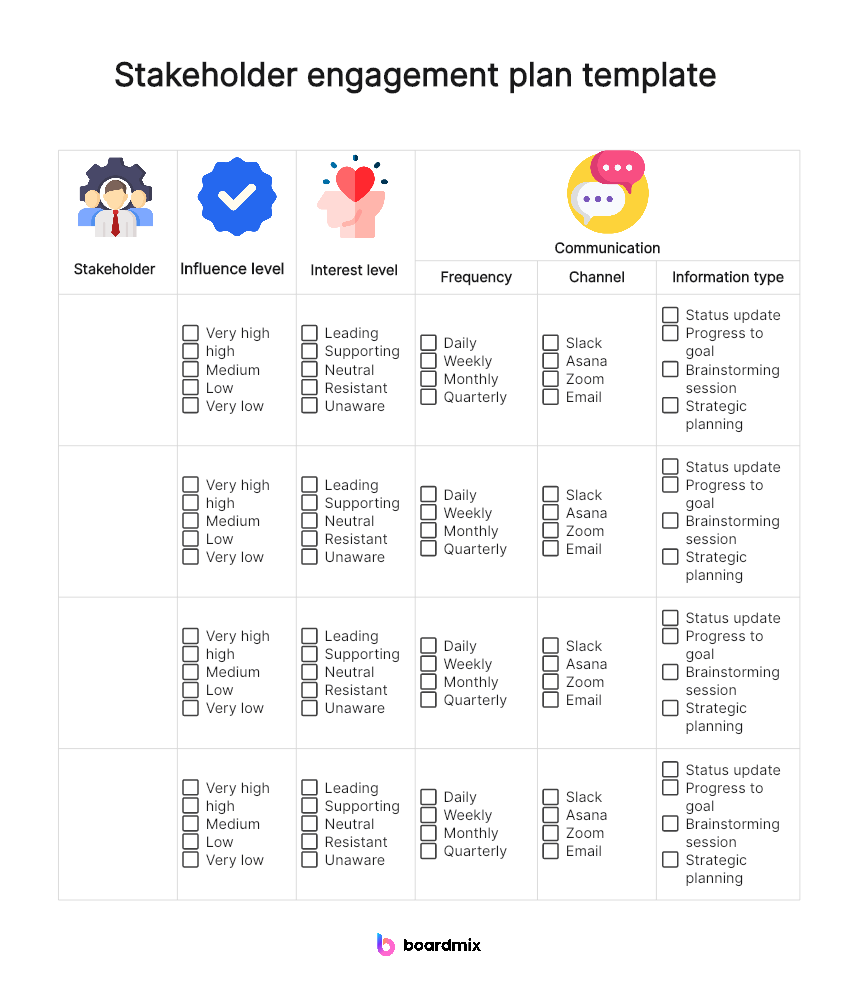A Stakeholder Engagement Plan is an essential roadmap for all organizations and businesses. It ensures robust and open communication between a project's managers and its stakeholders. With a well-crafted plan, you can identify, understand, and engage with your stakeholders more effectively, resulting in a successful project outcome.
What is a Stakeholder Engagement Plan?
A Stakeholder Engagement Plan is a blueprint that outlines an organization's strategy for interacting with its stakeholders - these could be individuals, groups, or institutions that have an interest in the project or can affect or be affected by its outcome. This strategy typically encompasses various activities like communication processes, engagement techniques, and continuous feedback loops that enable active participation of the stakeholders in the project lifecycle.
Benefits of Using a Stakeholder Engagement Plan
Implementing a Stakeholder Engagement Plan can transform the way your organization runs its projects, adding significant value to your project management process. Let's delve deeper into these advantages.
Manages Expectations
A Stakeholder Engagement Plan acts as a source of truth, outlining the details of the project and their roles in it. By continually engaging with and updating your stakeholders about the project progress, misunderstandings are mitigated. Expectations are aligned from the outset, avoiding potential conflicts or disappointments in the future. Everyone involved is on the same page regarding the project's scope, timeline, and desired outcomes.
Reduces Project Risks
Stakeholders offer diverse perspectives and can bring attention to potential risks or obstacles you might not have considered. Through their insights and input, you can identify potential issues early on, allowing you to take preventative measures before these issues escalate. The engagement plan creates a platform for stakeholders to voice their concerns and suggestions, contributing to effective risk management.
Builds Trust
A well-executed Stakeholder Engagement Plan promotes transparency in your operations. By involving stakeholders in critical decision-making processes and valuing their input, you cultivate an environment of trust and respect. Regular, open communication shows stakeholders that you value their contribution, fostering a more collaborative relationship.
Key Components of a Stakeholder Engagement Plan

A Stakeholder Engagement Plan is comprehensive and should contain key elements that facilitate clear and effective communication. Here are some crucial components:
- Stakeholder Name:It's vital to clearly identify all your stakeholders.
- Interest Level:Gauge their level of interest in the project. This will influence how you communicate with them.
- Influence Level:Determine each stakeholder's power or influence over the project's outcome.
- Communication Frequency:How often will you update each stakeholder? This can vary based on their interest and influence levels.
- Communication Channel Approach:Decide the best way to communicate with each stakeholder. Email? Meeting? Reports? The more personalized, the better.
Creating an Effective Stakeholder Engagement Plan
Let's delve into the step-by-step process of constructing a potent Stakeholder Engagement Plan.

Identify Your Stakeholders
It's pivotal to know who your stakeholders are. Consider using the five levels of stakeholder engagement: Unaware, Resistant, Neutral, Supportive, Leading - to gauge their stance regarding your project. The scale of stakeholder influence can also be a guiding factor to determine their significance to your project.
Map and Categorize Your Stakeholders
Post identification; it's time to map and categorize them on an Influence/Interest grid. This visual representation allows you to prioritize your stakeholders based on their interest and influence level.
Create a Communication Plan
This step includes deciding on the medium, frequency, content, and timing of communications for each stakeholder. For instance, high-interest high-influence stakeholders might need personalized frequent updates.
Collect and Analyze Stakeholder Feedback
Engagement is a two-way street. Ensure you solicit feedback from your stakeholders regularly. Reviewing and updating your engagement plan based on these inputs keeps your plan dynamic and effective.
Stakeholder Engagement Plan Template
To facilitate this process, we provide an example of a filled-in stakeholder engagement template that includes listing your stakeholders, rating their level of interest and influence, and outlining their communication plan.

Enhance Your Stakeholder Planning Process with Boardmix
Elevate your stakeholder planning process with Boardmix - a leading stakeholder map maker and online workspace. Its innovative features and intuitive templates make stakeholder engagement a streamlined process, leading to efficient and effective project management.
Creating a robust Stakeholder Engagement Plan is no small feat. But with systematic planning, prioritization, open communication, and regular feedback loops, you can establish a successful relationship with your stakeholders, ensuring the fruitful execution of your projects.













